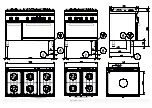
GB / IE - 1
5410.290.01
Part 1
Installation
GAS RANGES
General Instructions
The appliance described in this manual has been built in compliance
with the
EN 203
,
EN 437
,
EN 60335-1
,
EN60335-2-36
and
EN55014
standards. This appliance has been designed exclusively for cooking
food, any other use is considered improper.
It is meant to be used by qualified personnel in professional kitchens.
The unit must never be left unattended when it is being used! The
appliance should be checked once a year by a qualified technician.
Switch the appliance off in the case of a failure or malfunction.
The appliance should be installed under an extractor hood for removing the cooking fumes. Care must be taken when using the appliance because
the cooking surfaces are very hot. In the models
PP..
and
PFP..
, the plate can reach the maximum temperature of
420°C
. The appliance must be
installed, connected and serviced properly by qualified personnel according to the regulations and directives in force in the country where it is
installed, in compliance with the instructions included in this manual.
Unit characteristics
These installation and user's instructions manual refers to the category
II2H3+
gas ranges.
The self-adhesive polyester data plate "
T
" (pic.7) is behind the control
panel (inside the appliance).
It contains the following information:
PF_8GG7
xxx
II2H3+
xxx
26,5
A1
EN 203-1
G30
28-30/37 mbar
G20
20 mbar
G30 [Kg/h]
2,09
G20 [m
3
/h]
2,80
Modell
Serial number
Category
Consumption
Test base
Connection pressure
Year of manufacture
Nominal thermal capacity [kW]
Type of construction
The supplementary plate is also made of self-adhesive polyester and is
affixed near the data plate; it contains all the information regarding the
presetting of the appliance. The " "
(pic. 1) gas distribution network
fitting meets ISO 228-1 and EN 10226-1 standards with a ø ½” or a ¾’’
connection, situated on bottom of the machine. The appliance is made
of stainless steel, the burners are made of cast iron and the plate is
made of stainless steel. All models have adjustable feet. The main gas
pipe is made of galvanised steel. The pipes between the tap and burner
are made of copper.
Model
burners
Rings
Oven
PPF8GG7
1
9kW
7kW
PF_8GG7
4
1×3.3kW+2×5.5kW + 1×7.2kW
7kW
PF_8SGG7
4
4 × 7.2kW
7kW
PF_8G7
4
1×3.3kW+2×5.5kW + 1×7.2kW
4.7kW
PFP_8GG7
2 + 1
1×3.3kW+1×5.5kW+1×7.2kW
7kW
PFP_12GG7
4 + 1
1×3.3kW+2×4.5kW+1×7.2kW
7kW
PF_12GG7
6
2×3.3kW+2×4.5kW+2×7.2kW
7kW
PF_12G7
6
2×3.3kW+2×4.5kW+2×7.2kW
4.7kW
PFX_12GG7
6
4×5.5kW + 2×9kW
7kW
PF_X12GGE7
6
2×3.3kW+2×4.5kW+2×7.2kW
3kW
7kW
PF_X12G7
6
2×3.3kW+2×4.5kW+2×7.2kW
6.3kW
Install a shut-off cock in the line between the
appliance and the gas distribution network. Install an
omnipolar switch between the appliance and the
electrical distribution network.
Connection to the gas distribution network
Before you install the appliance, make sure that the gas
company has authorised the installation. Then, compare
the relevant data of the appliance (data plate) with the
local supply.
Remove the packaging from the appliance as well as the protective
plastic sheet, and, if necessary, remove traces of glue with a suitable
solvent. To dispose of the packaging, follow local directives (for more
details refer to the chapter “
ECOLOGY AND THE ENVIRONMENT
”.
Prior to connecting the unit to the gas network, check the data plate and
be sure that the unit has been set and tested for the type of gas
supplied. If the type of gas indicated on the data plate is not the same
as the one supplied, please refer to the paragraph “
CONVERSION
AND ADAPTATION
”.
To connect the appliance to the gas distribution network, metal pipes
with a suitable diameter must be used; install a homologated shut-off
cock between the appliance and the distribution network. If flexible
pipes are used, they must be made of stainless steel according to the
standards in force. When installing the appliance, all the regulations in
force must be observed, such as:
UNI-CIG 8723 safety standard, Act n. 46 of March 5th 1990 and
circular n.68.
Regional and/or local regulations, such as building codes;
Directives and regulations of the electricity board.
Accident prevention regulations in force;
Fire prevention regulations;
Applicable I.E.C. regulations.
We recommend installing the appliance in a well-ventilated
environment, or under an extraction hood to remove the fumes or
vapours produced during the cooking cycle.
Содержание PFP_12GG7
Страница 1: ...Fig 1 Abb 1 рис 1 ...













































